Fast food restaurants are a staple for US diners. But there’s more to quick service than the basic burgers and fries. Increasingly, US diners crave novelty. So, we’ve compiled 15 of the best fast food restaurant ideas and concepts to help you establish (or update) your quick service brand.
Key Takeaways:
- Plant-based and sustainable options are popular.
- Businesses built around entertainment or electric vehicle charging can be winners.
- Automation and technology can streamline your sales processes and boost your speed of service.
1. Plant-Based Fast Food
Plant-based foods have made enormous strides in the past few years, both with the development of user-friendly plant-based ingredients and in consumer popularity. According to research by the Good Food Institute, 6 out of 10 US households purchased plant-based foods in 2023. You could follow the example of the fast-growing Canadian plant-based quick service restaurant (QSR) Copper Branch, which created a menu of “power salads” and burgers made from 100% plant-based ingredients.

2. Automated QSR
Automation is one way to meet the challenges of rising labor costs and staff shortages. You don’t have to be like Sweetgreen and create a fully robotic restaurant; there are options for automation at all service and price levels. For example, you can add self-service kiosks at your order counter, via QR codes, or even AI-powered voice ordering at a drive-thru.
Many of these tools are affordable for even the smallest, newest QSRs. Several restaurant POS providers leverage consumer-grade tablets like iPads to support self-ordering kiosks. Voice ordering tools have never been more accessible with apps like SoundHound that integrate with popular POS systems like Square, Toast, and others.

Not all automation is for customers, either. Voice app companies have developed two-way AI chat assistants that can answer common questions for your staff. This can help QSRs where staff already wear headsets to communicate with coworkers and customers get the operational answers they need faster.
3. Quick Pick-Up QSR
Online ordering for takeout and delivery have continued to be popular since they spiked in 2020. But delivery charges can eat into your profits or make your food less affordable for customers. Adding a rapid pick up lane—like the option introduced by Panera—can meet customer desire for quick service and make excellent use of parking lot space.

At some locations, Panera chose to either remove an existing drive-thru lane or add an extra lane to offer this dedicated “rapid pick-up lane” to customers who ordered online. This rapid pick-up lane cuts costs from delivery services while still offering the quick pick-up interaction customers desire. It is a great idea for any QSR whose customers need quick and easy pick-up options.
4. EV-Fueled Fast Food Restaurant
Electric vehicle sales have been growing since 2016. The International Energy Agency reports that in the United States, new electric car registrations totaled 1.4 million in 2023, an increase of more than 40% from 2022. So why not load up a parking lot with EV charging stations and sell snacks while their vehicles charge?
Southern California-based Stack Charge sets a great example. Their first EV charging site, featuring 40 solar-powered EV charging stations surrounding a restaurant, is currently under construction in Baker, California (a major stop between Los Angeles and Las Vegas). They are currently looking for lessees to run the restaurant part of the operation.
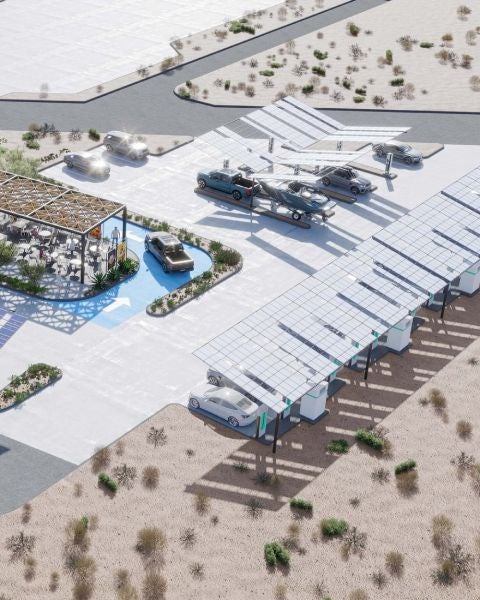
(Source: Stack Charge)
5. Omakase Espresso Experience
Omakase—the Japanese term for a “chef’s choice” meal—is no longer reserved for high-end food. The Espresso Omakase was a Yelp Trend in October 2024, increasing by 5173% year-over-year. The related term “coffee flight” also showed growth, up 81% in the same time period. Whichever term you prefer, it’s clear that customers are excited about samplers of coffee beverages.
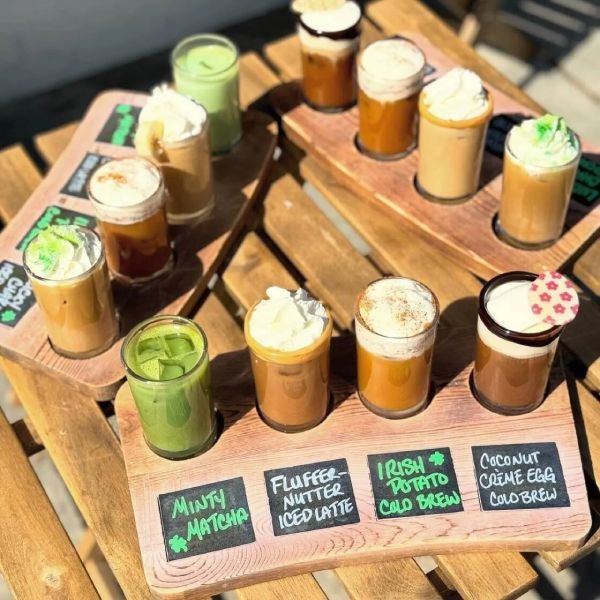
You can find inspiration for your own “chef’s choice” of coffee in the $80 experience served at Los Angeles specialty coffee shop Tangible Gratitude if you want to go high end). For a more casual vibe, look at the $20 coffee flight at Ancient Grounds in Chicago and the $15 flight from New Jersey’s Common Grounds.
6. Beverage First Concept
Coffee shops have long been a beverage-first, food-second quick service concept. But coffee is not the only option. In recent years, teas—specifically iced teas—have made enormous strides in the US market. According to the US Tea Association, more than half of Americans drink tea daily, and 75% to 80% of that tea is iced. Consider the rapid growth of Texas-based HTea0. From 2018 to 2024, this Amarillo-founded small business expanded into 14 states, all based on embracing America’s affinity for iced tea. HTea0 regularly brews 20 different flavors of tea and recently added coffee as a sideline.

Thinking about beverages first also works for concepts like boba shops and various other tea and coffee traditions, from Cuban coffees to Vietnamese coffee or traditional Indian chai. If you squint, you can also see pubs as a beverage-first quick service concept. Try to think outside the box. Is there a beverage that hasn’t been given its time in the spotlight? It could be time to craft a concept based on your favorite overlooked beverage.
7. Stuffed Burger Bar
In the US Midwest, they’re called a Juicy Lucy. In Korea, they get sauced and pinched and called UFO burgers. Either one turns the basic architecture of a burger on its head, filling either the meat patty or the bun with delicious fillings and sealing them in, rather than letting them run down the sides. UFO burgers, in particular, are enjoying a moment in the spotlight; in November 2024, Yelp searches for UFO burgers increased by 2959% year-over-year. Google Trends also shows increased search volume in general for UFO burgers, sealed burgers, and the tools you need to make them, like a UFO burger machine.

(Source: Spinning Buns)
This burger style involves constructing a burger with all the fixings—from cheese to onions, sauces, and pickles—and then sealing the sides of the bun to lock it all in. Fans say these burgers are less messy to eat and stay warmer longer.
The Juicy Lucy, on the other hand, revels in being a bit messier. A popular dish in Minnesota’s Twin Cities since its invention at Matt’s Bar in 1950, the Juicy Lucy involves encasing American cheese inside the burger patty. Inside the patty, the cheese becomes melty and gooey, basically saucing your burger with every bite. The Juicy Lucy has been a staple in the Midwest for years and is ripe for riffing with different combinations of meat and cheese.
8. Wings
Chicken wings are inexpensive, sharable, and support endless variations. They have long been popular with US football fans—in 2024, US consumers enjoyed 1.45 Billion chicken wings while watching the Super Bowl. One of the major restaurant success stories in 2024 was the growth of wing franchise Wing Stop, which was recently covered by CNBC.
That success was fueled —at least in part—by the emotional place wings hold for the American consumer. Wings are a staple for game group day viewing in all types of sports, from football to basketball and baseball. That has been a key element of their market strength. Industry analyst Jim Salera told CNBC:
“If you’re thinking about someone who has to make a decision on where to trim spending, the likelihood that they’re going to give up something that is associated with your social event is much lower.”
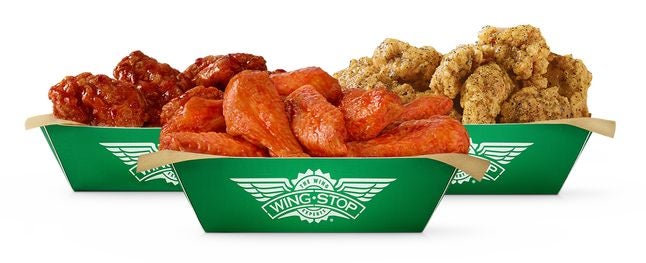
Chicken wings are sauced after cooking, so they lend themselves to endless flavor variations, from traditional buffalo wings to trendy hot honey, from Nashville hot chicken to Korean barbecue. You’ll also have an upsell on sides of dipping sauces that cool the heat, like blue cheese and ranch. And if you can get a liquor license in your location, you’re sure to find that salty, spicy chicken wings drive beer sales.
9. Traditional Mexican Food
Tacos have long been a fast food staple, but consumers—especially Gen Z—are increasingly familiar with more complex dishes from Central and South America. A recent Datassential poll found that 45% of Gen Z consumers say they’d choose Latin food if they could only eat one cuisine for the rest of their lives. Three out of the top 10 foods on Datassential’s list of most popular flavors are traditional Mexican dishes: the spicy beef stew birria hailing from Jalisco, Mangonada (the spicy, slushy frozen drink popular on Mexican food carts), and the thick, Veracruz-style salsa macha.
Any of these dishes could be the foundation for a grab-and-go concept. Mangonada could be the jumping-off point for a whole sweet, tangy, spicy beverage line. Salsa Macha is a perfect companion to seafood dishes that are also popular in the Veracruz region. Understanding and introducing concepts that include Mexican flavors beyond the basic taco can prove profitable in the coming years.
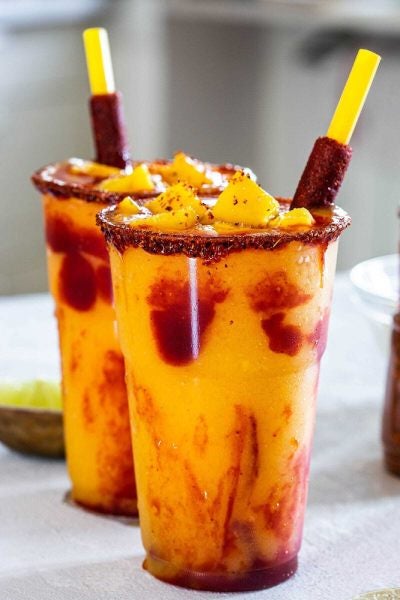
(Source: La Bodega Taco)
10. GLP-1 Focused Food
While weight loss and fast food may not go hand-in-hand, some QSR concepts are launching dietary-focused menu options for users of Glucagon-like peptide-1 (GLP-1) drugs like Ozempic. For example, Smoothie King recently announced that they are launching GLP-1-focused smoothies for their customers. With many economists predicting that Americans’ use of GLP-1 drugs will affect the fast food business, it is a good idea to create a concept or a menu segment that compliments how these drugs operate.

Customers who take GLP-1 medications should avoid foods with excess fats and sugars, focusing instead on lean proteins, leafy greens (like kale, spinach, and other nonstarchy vegetables), healthy fats (almonds, avocados), whole grains, and low-glycemic fruits (like berries). These guidelines can inspire grab-and-go salads, grain bowls, and, yes—even smoothies. Restaurant owners need to look no further for inspiration. As Nation’s Restaurant News reported, a recent survey by William Blair found that customers who take GLP-1 medications visited the plant-forward chain Sweetgreen more often after starting the drug.
11. Premium Ingredient Fast Food Concept
A recent survey by Ingredion found that 75% of consumers are interested in making “better” food and beverage choices. Many, (42%), are looking specifically for “natural ingredients” and 33% of consumers are willing to pay up to 20% more for premium ingredients.
Take a look at premium fast food brand Shake Shack for inspiration. They recently ran a promotional “Worth It” ad campaign that focuses on the higher quality of their ingredients over other fast food burgers.
You can focus on premium ingredients with any type of food, whether your QSR concept is based on barbecue, tacos, burgers, salads, pasta, or more. Focus on the quality of your ingredients and promote that quality across all your marketing channels to capture the attention of quality-minded customers.
Look for ingredients that help you keep your prices reasonable; this is fast food, after all. Your premium fast food dishes should only cost a little bit more than nonpremium versions. Stay within 20% of the prices of your nearest competitor, and you should have a winning formula.
12. Sustainability-based Quick Service
Fast food is about more than just the food; you also have to consider your packaging. Recent research from LEK found that 68% of consumers made a food purchase based on sustainability concerns in the last 12 months.
Fast food companies are getting ahead of the sustainability trends, focusing on eliminating single-use plastic, using sustainable materials, and avoiding excess waste when possible. The biggest sustainability shift in the fast food sector came from McDonald’s announcing they reached 86.7% of their goal of having 100% of primary guest packaging from renewable, recycled, or certified materials.
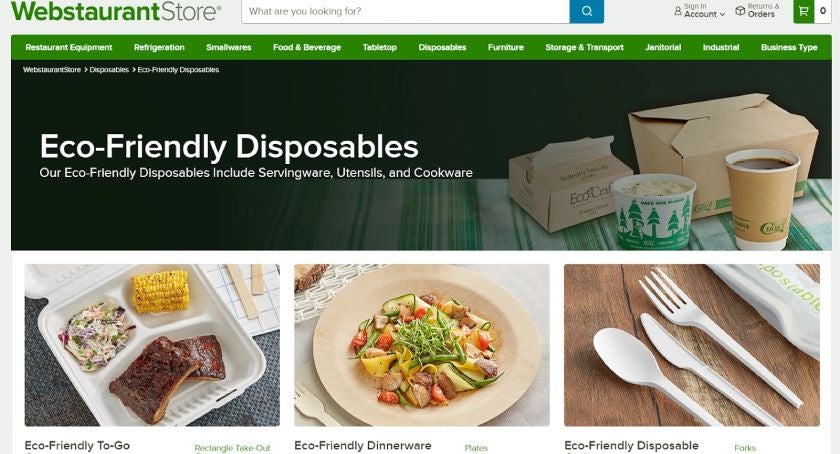
(Source: WebstaurantStore)
If you manage a fast food restaurant, then investing in and sharing your sustainability initiatives is an excellent way to increase consumer sentiment toward your brand. Sourcing sustainable packaging doesn’t need to be difficult. Most major suppliers include a sustainable or eco-friendly packaging category in their product catalogs.
13. Entertainment-focused Fast Food
Chick-fil-A is launching a new app called Chick-fil-A Play, allowing you to play games, watch animated shows, and listen to kid-friendly podcasts. An entertainment app might be inaccessible to smaller, independent fast food concepts, but there are many ways to embrace the basic idea of adding entertainment to your menu.
Arcade games offer a nostalgic throwback for Gen X and Millennial customers (who might also be excited to introduce them to their kids). Vintage photo booths—you know the ones with a velvet curtain that spit out bookmark-sized photo prints–are also enjoying a surge of popularity with younger consumers after viral TikTok posts shined a new light in them.

In most locations, you can easily find companies that rent out arcade games and photo booths. Trivia nights and themed celebrations are also great community-building events that drive loyalty and customer engagement.
14. Elevated Food Hall
A food hall is a single brick-and-mortar location that houses several independent, local food concepts under the same roof. Food halls appeal to families and groups of friends who can never agree on what to eat when dining out. In a food hall, one person can have their tacos while their date enjoys sushi or tandoori chicken. Research by CivicScience has shown that 71% of urban residents and 66% of suburban consumers had dined at a food hall in 2024. A majority of food hall customers (62%) are also major supporters of small, local restaurants over chain businesses.

Beyond attracting locally-minded customers, food halls reduce operational costs for restaurant owners. By operating out of a food hall, you share the costs of sanitation, security, marketing, and licensing with other businesses. The startup costs also tend to be lower. Starting up a stall in an established food hall can cost as little as $50,000. This is a fraction of the $250,000 to $2 million it can cost to open a new restaurant.
15. College Campus-Focused Fast Food
College towns have always given fast food concepts a boost. New developments in partnerships between major universities and third-party delivery platforms are making college campus-focused fast food an even sweeter option for independent restaurants. Third-party platform Grubhub recently launched its Campus Dining program, which allows college students to use their meal plan’s “Flex” funds to purchase food from Grubhub vendors. Students get the food they crave, restaurants easily unlock a new revenue stream, and universities get a small commission on each sale. It’s a win-win-win for operators in college towns. Grubhub saw its orders grow by 30% in 2023 for Campus Dining, and they expect it to grow even further in 2024 through 2025.

Even without a Grubhub partnership, proximity to a college campus can boost sales for independent QSRs. Beyond the student population, there are also university faculty and staff and a number of annual events, from homecoming to graduation, that people want to celebrate with food.
What Reddit Users Say
When you are looking for fast food restaurant ideas, community forums like Reddit can also offer a lot of food for thought. We filtered through the Reddit restaurant community subreddits to find some of the most useful concepts mentioned there.
Use Creative Events to Draw a Crowd
One Reddit restaurant owner mentions staging a weekly “DJ” party at his location where the customers submit their song choices on slips of paper, and the staff updates the playlist in real time. Trivia nights are also popular suggestions; many restaurant owners say trivia nights give them two hours of boosted sales on a typically slow night. Just ensure the host is excellent; Redditors agree that the host is the most important part of a successful trivia night.
Just take care if you plan any events based on music. To legally play live or recorded music in your venue, you’ll need licenses from performing rights organizations or PROs. Some Reddit restaurant owners have been sued by one or all of the three PROs—SESAC, ASCAP, and BMI. Each service charges an annual fee (from $400 to more than $1,500) based on how you feature music (recorded or live performances) and your business size. The fees might sound expensive, but the fines for playing music without them can be ten times higher.
Check Demographics
In every Reddit conversation about fast food concepts, restaurant owners advise future owners to pay attention to identifying their target customers and finding a location near those customers. A high business volume is crucial to keeping a fast food restaurant going. So don’t overlook your ideal customers, their budgets, and the types of food that will appeal to them.
Cook What You Love
Many Reddit restaurant owners advise new and aspiring quick service owners to design menus around foods they personally enjoy. If you’re not passionate about sandwiches, consider noodles. If you love tacos, start with your favorite fillings and develop the rest of your menu from there.
Fast Food Restaurant Frequently Asked Questions (FAQs)
Fast food restaurants are always evolving, and so are the best ideas for them. While this restaurant type is everywhere, there are still plenty of questions regarding it. Below are commonly asked questions about fast food restaurants.
Last Bite
The potential in the fast food space is quite promising. Connecting with customers and meeting their needs never goes out of style. Innovation continues to be a trend that helps fast food brands grow and reach new customers. The biggest takeaway from the ideas above is that fast food customers are savvy, so being thoughtful in your concept, product offering, and marketing campaigns is key to financial success.
ALSO READ



